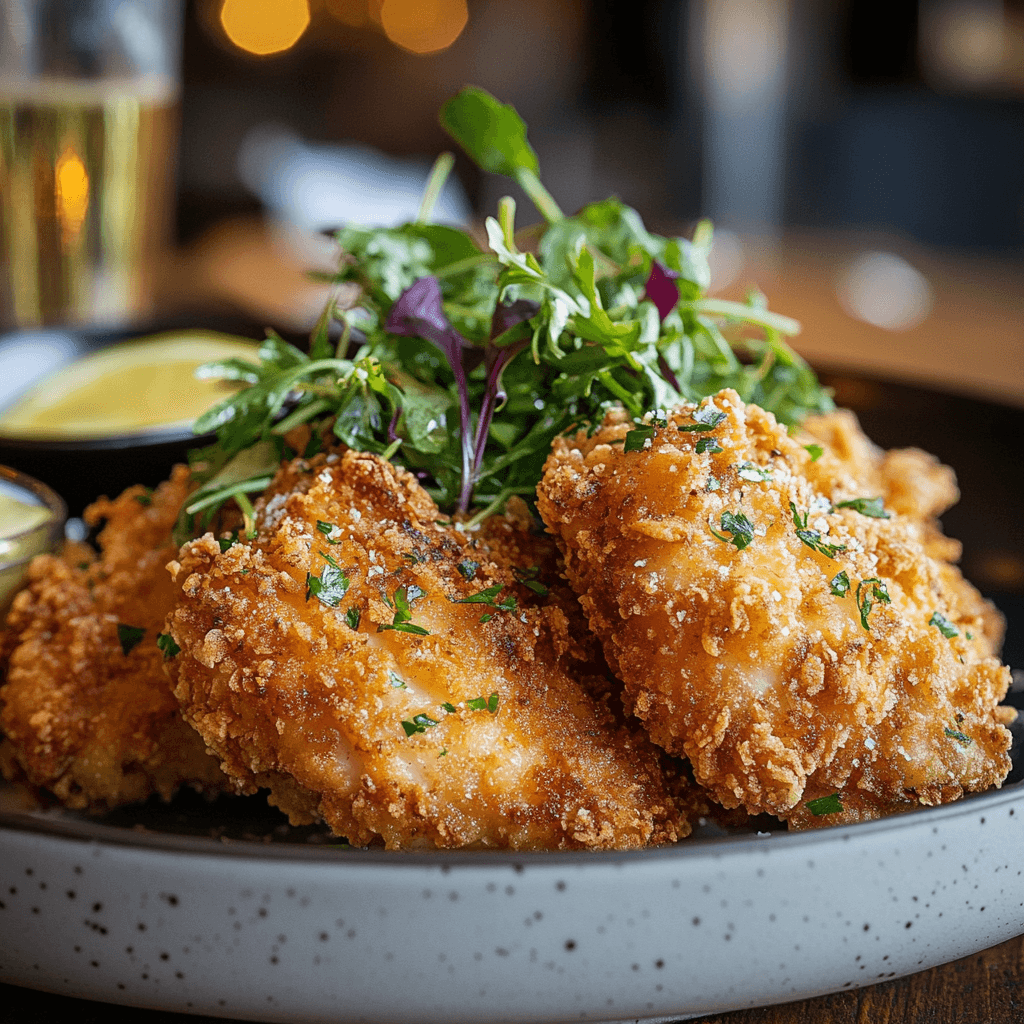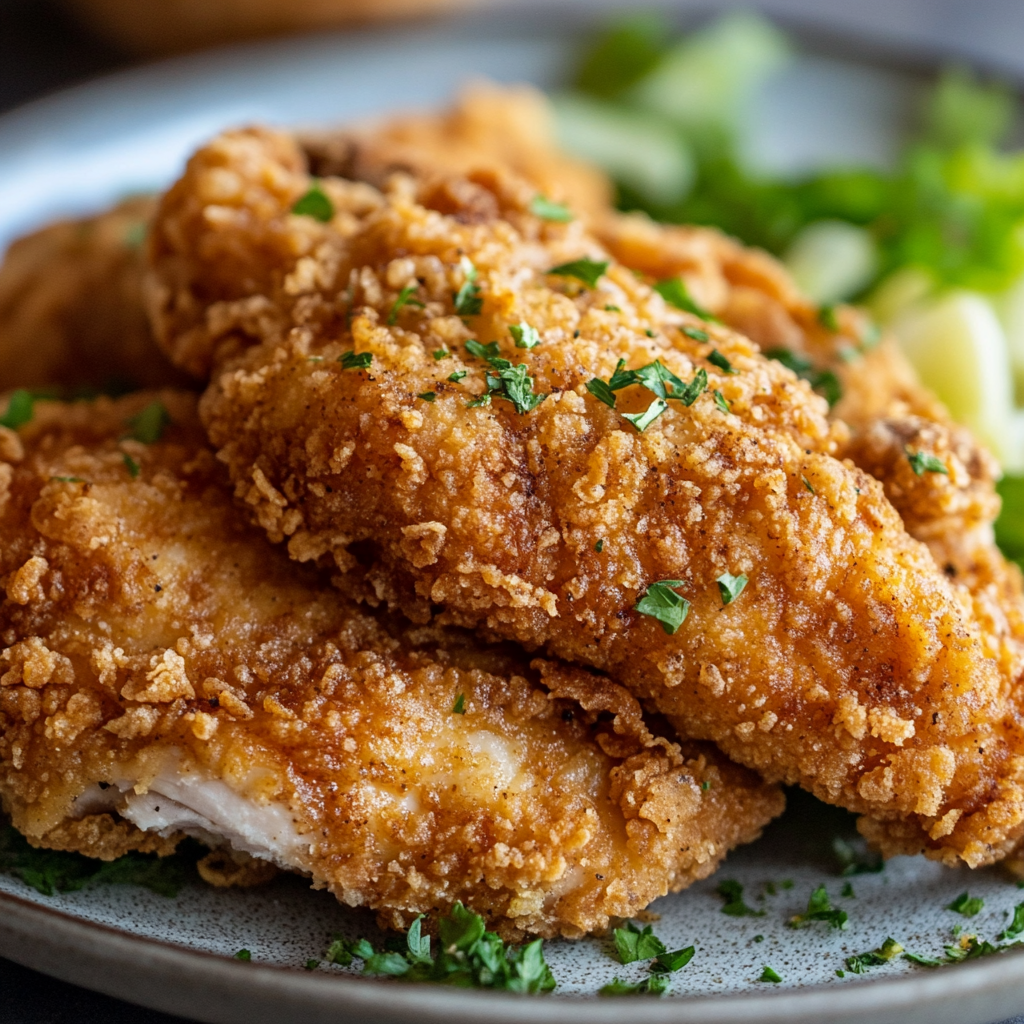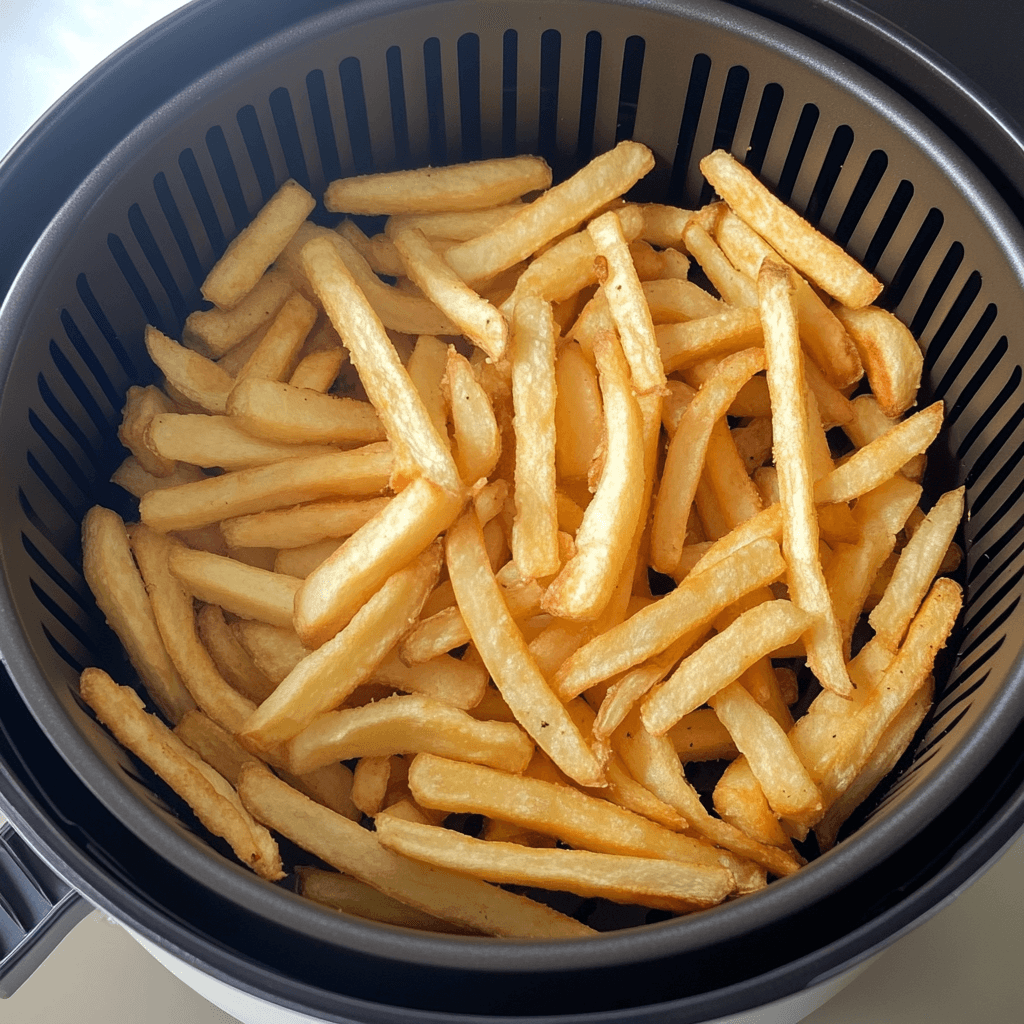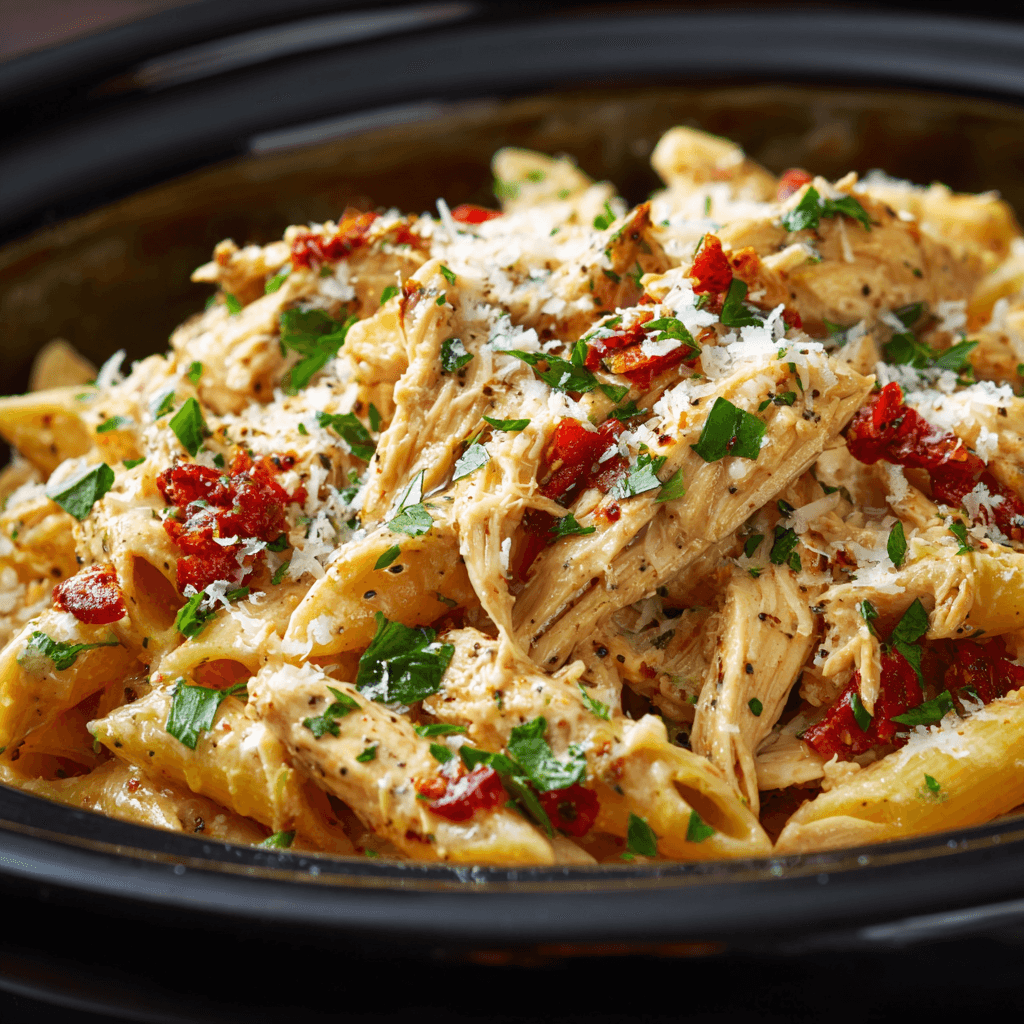Introduction to Fried Chicken Breast Recipe
Why Fried Chicken Breast Is a Timeless Favorite
If you’re searching for the ultimate fried chicken breast recipe, you’ve come to the right place. This recipe delivers a perfectly crispy crust and tender, juicy meat that’s ideal for everything from weeknight dinners to special occasions. Whether you’re a beginner or an experienced cook, this guide will help you create fried chicken that is flavorful, satisfying, and guaranteed to impress.
The Key to Perfectly Fried Chicken Breast
Achieving perfectly fried chicken breast requires attention to a few essential details. First, season and marinate the chicken properly to enhance its flavor and juiciness. Next, coat the chicken in a well-balanced breading to create a crispy, golden exterior. Frying at the right oil temperature—around 350°F (175°C)—cooks the chicken evenly and prevents the coating from burning. Mastering these steps ensures a perfectly crispy and delicious result every time.
How This Recipe Stands Out from the Rest
This recipe stands out because it combines traditional techniques with modern enhancements for superior flavor and texture. For example, spices like paprika and garlic powder add depth to the breading, making it more flavorful than basic recipes. In addition, tips for locking in moisture while creating a crisp crust make this recipe unique. Whether you’re preparing a casual meal or cooking for a special occasion, this fried chicken breast recipe delivers consistently impressive results.
By actively focusing on technique and flavor, this recipe avoids common pitfalls and produces fried chicken breast that’s both crispy and juicy, ensuring every bite is a delight.
IngredieIngredients for Fried Chicken Breast Recipe
Essential Ingredients: Chicken, Flour, Spices, and Oil
To create the perfect fried chicken breast, a few key ingredients are necessary. First, choose boneless, skinless chicken breasts for a uniform and tender result. Next, use all-purpose flour as the base for the breading, which provides the crispy outer layer. Additionally, season the chicken with salt, pepper, and your favorite spices to enhance its flavor. Finally, select a high-smoke-point oil such as vegetable, peanut, or canola oil for deep frying. By maintaining the oil temperature at around 350°F (175°C), you ensure even cooking and a golden crust.
Optional Flavor Enhancers: Buttermilk, Paprika, Garlic Powder
For an extra flavor boost, consider incorporating these optional ingredients:
- Buttermilk: Marinating the chicken in buttermilk for a few hours or overnight tenderizes the meat and enhances juiciness. As a result, the chicken stays moist and flavorful.
- Paprika and Cayenne Pepper: Adding these spices to the flour mixture provides a smoky depth and subtle heat, making the breading more exciting.
- Garlic Powder and Onion Powder: These aromatic spices elevate the flavor profile, creating a savory, irresistible coating.
- Breadcrumbs or Cornstarch: Mixing a small amount with the flour ensures an even crispier texture. In addition, these ingredients help the breading adhere better to the chicken.
Choosing the Right Type of Oil for Frying
Selecting the right oil is crucial for achieving crispy, golden fried chicken breasts.
- High-Smoke-Point Oils: Oils such as vegetable, peanut, canola, or sunflower oil are ideal because they withstand high heat without breaking down.
- Flavor-Neutral Options: Choose oils with a mild taste so the seasoning on the chicken shines through. For instance, vegetable or canola oil works well for frying without altering the flavor.
- Reusing Oil: After frying, strain the oil to remove any debris, and store it in a clean container for reuse. However, avoid reusing oil that has absorbed too much flavor or become cloudy.
By combining these essential and optional ingredients, you can create fried chicken breasts that are crispy, flavorful, and perfectly cooked every time. Furthermore, selecting the right oil ensures a professional-quality result that’s sure to impress.
Equipment Needed for Fried Chicken Breast
Essential Tools for Frying: Skillet, Deep Fryer, Thermometer
To achieve perfectly fried chicken breast, having the right equipment is crucial.
- Skillet or Cast-Iron Pan: A heavy-bottomed skillet, preferably cast iron, provides even heat distribution and helps maintain the oil temperature.
- Deep Fryer: If you prefer, a deep fryer offers more control over temperature and ensures consistent results. However, a skillet works just as well for home cooking.
- Thermometer: A kitchen thermometer is essential for monitoring the oil temperature, which should stay around 350°F (175°C) for optimal frying. This tool helps prevent undercooked chicken or burning the breading.
Prepping Utensils: Mixing Bowls, Tongs, and Racks
Proper preparation and handling tools make frying easier and more efficient:
- Mixing Bowls: Use one large bowl for marinating the chicken and another for dredging it in the breading mixture. By organizing your prep area, you’ll keep the process clean and efficient.
- Tongs: Long-handled tongs allow you to safely place chicken into the hot oil and turn it without splattering. Additionally, they provide better control than using a fork.
- Wire Racks: Place a wire rack over a baking sheet to let the chicken rest after frying. This setup prevents sogginess by allowing excess oil to drip off.
Safety Tools for Deep Frying
Safety is important when working with hot oil, as frying involves high temperatures and potential splatter.
- Splatter Guard: A splatter guard placed over the skillet reduces mess and minimizes the risk of burns from oil splashes.
- Heat-Resistant Gloves: Wear heat-resistant gloves or use potholders to protect your hands when handling hot equipment.
- Fire Extinguisher: Always keep a kitchen-safe fire extinguisher nearby in case of emergencies. Remember, never use water to extinguish an oil fire.
By equipping your kitchen with these essential tools and safety measures, you can fry chicken breasts confidently and enjoy crispy, delicious results every time.
Preparing the Chicken Breasts
Slicing and Tenderizing Chicken for Even Cooking
Preparing chicken breasts properly is crucial for achieving even cooking and perfect texture.
- Slicing: If the chicken breasts are thick, slice them horizontally into thinner, even pieces. This step ensures the chicken cooks evenly and prevents the outside from burning before the inside is fully cooked.
- Tenderizing: Use a meat mallet or the bottom of a heavy pan to gently pound the chicken to a uniform thickness. Additionally, tenderizing helps soften the meat, making it more enjoyable to eat. Place the chicken between two pieces of plastic wrap to avoid mess during the process.
Brining for Extra Juiciness
Brining is a simple but effective way to lock in moisture and enhance flavor.
- Why Brine?: Brining the chicken adds moisture, ensuring it stays juicy even after frying. As a result, you’ll avoid dry or tough meat.
- How to Brine: Dissolve 1/4 cup of salt in 4 cups of water. Submerge the chicken in the solution for at least 30 minutes, or up to 4 hours for more flavor. For extra flavor, add sugar, garlic, or herbs to the brine.
- Tip: Rinse the chicken lightly after brining and pat it dry before dredging to prevent the coating from clumping.
Marinating Options for Deep Flavor
Marinating adds layers of flavor to your fried chicken, making every bite irresistible.
- Buttermilk Marinade: Soak the chicken in buttermilk, garlic, paprika, and a pinch of cayenne for a classic and tenderizing marinade.
- Herb and Lemon Marinade: Combine olive oil, lemon juice, minced garlic, and fresh herbs like thyme or rosemary. This option works well for a fresh and zesty twist.
- Spicy Marinade: Mix hot sauce, soy sauce, and a dash of honey for a sweet-and-spicy flavor that complements crispy fried chicken.
- How Long to Marinate: For the best results, marinate the chicken for at least 2 hours or overnight in the refrigerator. This extra step infuses the meat with bold flavors.
By following these preparation techniques, you’ll set the foundation for fried chicken that is tender, juicy, and full of flavor. Taking the time to slice, brine, and marinate ensures your chicken turns out perfectly every time.
Creating the Perfect Breading for Fried Chicken Breasts
Classic Flour-Based Coating
A flour-based coating is the foundation of perfectly breaded fried chicken breasts.
- Step 1: Use All-Purpose Flour: This type of flour provides the best texture for a crispy crust. If desired, you can mix in breadcrumbs for added crunch.
- Step 2: Layering the Coating: First, dredge the chicken in flour, then dip it in beaten eggs or buttermilk, and finish with another layer of flour. This layering process ensures the breading adheres properly and creates a thick, even crust.
- Tip: Shake off excess flour after each layer to avoid a clumpy coating.
Adding Spices for Extra Flavor
Spices are essential for elevating the flavor of your fried chicken.
- Classic Seasonings: Add salt, pepper, garlic powder, and paprika to the flour for a simple yet flavorful blend.
- Bold Flavors: Include cayenne pepper for heat, onion powder for depth, or dried herbs like oregano for an earthy note.
- Pro Tip: Mix the spices directly into the flour to evenly distribute the flavor. For even more impact, sprinkle some spices on the chicken before dredging.
Using Cornstarch for Extra Crispness
Cornstarch is a game-changer when it comes to achieving ultra-crispy fried chicken.
- Why Use Cornstarch?: Adding cornstarch to the flour mixture lightens the coating, creating a crispy and airy texture. As a result, your chicken will have that sought-after crunch.
- Recommended Ratio: Combine 2 parts flour with 1 part cornstarch for the best results.
- Additional Tip: For an extra crunch, consider adding a small amount of baking powder to the breading mixture.
By using a classic flour-based coating, enhancing it with spices, and incorporating cornstarch, you can create breading that’s flavorful, crispy, and perfect for fried chicken breasts. These techniques ensure every bite is irresistibly crunchy and delicious.
SStep-by-Step Instructions for Fried Chicken Breast Recipe
Prepping the Chicken
Proper preparation is essential to create juicy and flavorful fried chicken breasts.
- Trim and Slice: Begin by slicing thick chicken breasts horizontally into thinner portions. This ensures even cooking and prevents undercooked centers.
- Tenderize: Gently pound the chicken with a meat mallet to create uniform thickness. As a result, the chicken will cook evenly and remain tender.
- Brine or Marinate: For added moisture, brine the chicken in a saltwater solution for at least 30 minutes. Alternatively, marinate it in buttermilk mixed with garlic, paprika, or your favorite spices to enhance the flavor.
Setting Up the Dredging Station
An organized dredging station simplifies the breading process and ensures a consistent coating.
- Prepare the Flour Mixture: In a shallow bowl, combine all-purpose flour with salt, pepper, paprika, and garlic powder. Additionally, you can add cornstarch for extra crispiness.
- Set Up the Wet Layer: In a second bowl, whisk together eggs or buttermilk to serve as a binding agent. This step helps the flour adhere better to the chicken.
- Include a Final Coating: For an extra crunch, add breadcrumbs to the flour mixture or use panko for a lighter texture.
Dredging Process:
- First, coat the chicken in the seasoned flour, shaking off any excess.
- Next, dip it into the egg or buttermilk mixture, ensuring every part is covered.
- Finally, dredge it again in the flour mixture, pressing gently to create a thick and even coating.
Frying the Chicken to Golden-Brown Perfection
The frying process is critical for achieving a crispy exterior and a juicy interior.
- Heat the Oil: Pour vegetable, canola, or peanut oil into a deep skillet or fryer and heat it to 350°F (175°C). To maintain the temperature, use a kitchen thermometer and avoid overcrowding the pan.
- Fry in Batches: Place a few pieces of chicken in the oil at a time, leaving space between them. This prevents the temperature from dropping and ensures even frying.
- Cook Thoroughly: Fry each piece for 3–5 minutes per side, flipping once, until golden brown. Additionally, check that the internal temperature reaches 165°F (74°C) before removing the chicken from the oil.
Draining and Resting for Maximum Crispness
Proper draining and resting ensure the fried chicken retains its crispy texture.
- Drain Excess Oil: Transfer the chicken to a wire rack set over a baking sheet. This allows the oil to drip off while keeping the coating crisp. Avoid placing it directly on paper towels, as this can create steam and soften the crust.
- Let It Rest: Allow the chicken to rest for 5 minutes before serving. During this time, the juices redistribute, keeping the meat moist while the crust remains perfectly crispy.
By following these detailed steps and techniques, you can create fried chicken breasts that are irresistibly golden, crispy, and flavorful. Serve immediately for the best taste and texture!
Tips and TrTips and Tricks for Perfectly Fried Chicken Breasts
Maintaining Oil Temperature for Even Cooking
Maintaining the correct oil temperature is essential for evenly cooked fried chicken.
- Monitor Constantly: Always use a thermometer to keep the oil at 350°F (175°C). If the temperature drops, the chicken will absorb too much oil, resulting in a greasy texture. On the other hand, if it gets too hot, the coating will burn before the chicken is fully cooked.
- Avoid Overcrowding: Fry the chicken in small batches. This ensures the oil temperature stays consistent and each piece cooks evenly with a golden crust.
- Adjust the Heat: If the oil temperature fluctuates, adjust the burner slightly to bring it back to the optimal range. As a result, you’ll achieve consistently crispy and well-cooked chicken.
Preventing Soggy Coating
A soggy coating can ruin the texture of fried chicken, but a few simple adjustments can prevent this.
- Dry the Chicken Thoroughly: Pat the chicken dry with paper towels before breading. As a result, the coating will adhere better and fry to a crispier texture.
- Double Dredge for Crispiness: Coat the chicken in flour, dip it in the wet mixture, and dredge it again in flour. By layering the breading, you create a thicker, more durable crust.
- Drain Properly: After frying, place the chicken on a wire rack over a baking sheet instead of directly on paper towels. This method allows excess oil to drip off while keeping the coating crunchy.
Achieving Juicy Meat with Crispy Skin
The key to great fried chicken is balancing juicy meat with a crispy outer layer.
- Brine or Marinate: Soak the chicken in a saltwater brine or buttermilk marinade for at least 30 minutes. In addition, this step helps the meat stay tender and flavorful.
- Choose the Right Oil: Use neutral oils like peanut, canola, or vegetable oil that can withstand high heat. Moreover, these oils won’t overpower the chicken’s seasoning.
- Monitor Internal Temperature: Cook the chicken until it reaches an internal temperature of 165°F (74°C). By doing so, you’ll avoid undercooking or drying out the meat.
By following these tips and tricks, you can ensure your fried chicken breasts are perfectly crispy and juicy every time. Furthermore, these techniques will elevate your cooking and make your fried chicken a guaranteed hit.
Variations of Fried Chicken Breast Recipe
Classic Southern-Style Fried Chicken
Southern-style fried chicken is a timeless favorite known for its flavorful seasoning and golden, crispy crust.
- Seasoning: Use a mixture of paprika, garlic powder, onion powder, salt, and black pepper in the flour coating. For extra flavor, add a pinch of cayenne.
- Cooking Method: Dip the chicken in buttermilk before dredging it in the seasoned flour to create a thick, flaky crust.
- Serving Suggestion: Pair with classic sides like mashed potatoes, coleslaw, or cornbread for a true Southern meal.
Spicy Fried Chicken Breast with Cayenne and Hot Sauce
For those who love heat, spicy fried chicken breast adds bold flavors to the traditional recipe.
- Marinade: Soak the chicken in buttermilk mixed with hot sauce and cayenne pepper for at least 2 hours. This step infuses the meat with spicy flavor.
- Spiced Breading: Add cayenne pepper, smoked paprika, and chili powder to the flour mixture.
- Serving Suggestion: Serve with ranch or blue cheese dipping sauce to balance the heat, and include a side of fries for a satisfying meal.
Gluten-Free Fried Chicken Using Almond Flour
For a gluten-free alternative, almond flour provides a nutty flavor and crispy texture.
- Flour Substitute: Replace all-purpose flour with almond flour or a mix of almond flour and cornstarch.
- Cooking Tip: Use egg whites as the binding agent for the breading, as almond flour adheres better this way.
- Serving Suggestion: Pair with a fresh salad or roasted vegetables for a lighter gluten-free meal.
Air-Fried Chicken Breast for a Healthier Option
Air-frying offers a healthier twist on fried chicken without compromising on flavor or crunch.
- Preparation: Coat the chicken with seasoned flour or panko breadcrumbs. Lightly spray the chicken with cooking oil to help it crisp up in the air fryer.
- Cooking Method: Preheat the air fryer to 375°F (190°C) and cook the chicken for 12–15 minutes, flipping halfway through for even crispiness.
- Serving Suggestion: Serve with a side of steamed vegetables or baked sweet potatoes for a guilt-free meal.
These variations showcase the versatility of fried chicken breast recipes. Whether you prefer traditional Southern flavors, a spicy kick, gluten-free options, or healthier air-fried versions, there’s a recipe to suit every craving and occasion.
Delicious Sauces and Dips for Fried Chicken Breasts

Classic Dips: Ranch, BBQ Sauce, and Honey Mustard
Classic dips are timeless companions for fried chicken breasts, as they complement the savory and crispy flavors beautifully.
- Ranch Dressing: Creamy and tangy, ranch provides a refreshing contrast to the chicken’s crispiness. Additionally, it pairs equally well with both spicy and mild chicken.
- BBQ Sauce: Sweet and smoky, BBQ sauce enhances the flavor of Southern-style fried chicken. Moreover, you can experiment with different varieties like hickory-smoked, spicy, or honey BBQ for unique flavor combinations.
- Honey Mustard: The sweet and tangy blend of honey mustard creates a perfect balance against the savory flavors of fried chicken. For a twist, try adding a touch of Dijon for extra depth.
Spicy Options: Buffalo Sauce, Sriracha Mayo
If you enjoy bold and spicy flavors, these sauces will take your fried chicken to the next level.
- Buffalo Sauce: Made with hot sauce and butter, buffalo sauce offers a tangy, spicy kick. For extra richness, serve it alongside ranch or blue cheese dressing to cool the heat.
- Sriracha Mayo: Combining Sriracha with mayonnaise creates a creamy dip with just the right amount of heat. Furthermore, this sauce pairs especially well with fried chicken sliders or tenders.
Unique Pairings: Garlic Aioli, Sweet Chili Sauce
Unique and creative sauces can elevate your fried chicken to a gourmet experience.
- Garlic Aioli: This dip, made from garlic, mayonnaise, and lemon juice, adds a rich and savory twist. As a bonus, it works well not only as a dip but also as a spread for chicken sandwiches or wraps.
- Sweet Chili Sauce: With its perfect balance of sweet and spicy, sweet chili sauce is a fantastic option for adding an Asian-inspired flavor. In addition, it doubles as a glaze for fried chicken wings or drumsticks.
By incorporating these delicious sauces and dips, you can add variety and excitement to your fried chicken dishes. Whether you prefer classic favorites, bold spicy options, or unique gourmet pairings, there’s a sauce for every taste and occasion.
Serving Suggestions for Fried Chicken Breasts
Classic Sides: Mashed Potatoes, Coleslaw, and Biscuits
Classic sides are essential for turning fried chicken breasts into a well-rounded, satisfying meal.
- Mashed Potatoes: Creamy mashed potatoes complement the crispy texture of fried chicken. In addition, topping them with gravy enhances the overall flavor. For more variety, you can add roasted garlic or chives to the potatoes.
- Coleslaw: The tangy crunch of coleslaw balances the richness of fried chicken. Moreover, its refreshing texture makes it an excellent addition to the meal.
- Biscuits: Buttery, flaky biscuits are a perfect pairing with fried chicken. Furthermore, serving them with honey or jam adds a delightful touch of sweetness.
Fresh Salads to Balance the Richness
Fresh salads not only provide a burst of flavor but also help balance the richness of fried chicken breasts.
- Garden Salad: A simple salad made with lettuce, cucumbers, tomatoes, and a light vinaigrette offers a refreshing contrast. Additionally, you can add croutons or shredded carrots for extra crunch.
- Spinach and Strawberry Salad: Combining sweet strawberries, fresh spinach, and balsamic vinaigrette creates a unique and tangy pairing. For added flavor, sprinkle goat cheese or candied walnuts on top.
- Caesar Salad: The creamy dressing, crisp romaine lettuce, and Parmesan cheese in a Caesar salad pair wonderfully with the savory, crunchy chicken. Moreover, adding croutons enhances its texture and makes it more filling.
Beverage Pairings: Iced Tea, Lemonade, or Craft Beer
The right beverage can enhance the flavors of fried chicken breasts while adding a refreshing touch to your meal.
- Iced Tea: Sweet or unsweetened iced tea is a classic Southern pairing. In particular, adding lemon or mint can elevate the flavor.
- Lemonade: Bright and tangy, lemonade cuts through the oiliness of fried chicken. Furthermore, flavored options like raspberry or peach lemonade bring a fun twist.
- Craft Beer: A crisp lager or light ale complements the crispy chicken without overpowering it. For a bolder choice, try a hoppy IPA or a smooth amber ale to add depth to the pairing.
By incorporating these serving suggestions, you can create a complete meal that highlights the delicious flavors of fried chicken breasts. Whether you choose comforting sides, fresh salads, or refreshing beverages, these pairings elevate your dining experience to the next level.
Nutritional Breakdown of Fried Chicken Breast Recipe
Calories, Protein, and Fat Content
Fried chicken breasts are a hearty source of protein but also contain higher calorie and fat levels due to the frying process. On average, a single fried chicken breast (approximately 4 ounces) contains:
- Calories: 300–400 kcal, depending on the breading and frying oil used.
- Protein: 25–30 grams, making it a good option for muscle repair and growth.
- Fat: 15–20 grams, with a portion of it coming from the oil used in frying.
Keep in mind, the exact nutritional content varies based on preparation methods, breading, and portion size.
Adjustments for Low-Calorie Versions
To make fried chicken breasts healthier and lower in calories, you can make simple adjustments without sacrificing flavor:
- Air Frying: Use an air fryer instead of deep-frying to significantly reduce the oil and fat content. This method delivers a crispy texture with fewer calories.
- Lighter Breading: Use a thinner coating of seasoned flour or substitute breadcrumbs for panko to minimize calorie intake.
- Lean Oils: Opt for oils like avocado or light olive oil that are healthier and require less quantity for frying. By choosing these options, you can still achieve a satisfying result with fewer calories.
Substituting Ingredients for Dietary Preferences
For those with specific dietary needs, substituting traditional ingredients can make fried chicken breasts more suitable:
- Gluten-Free Options: Replace all-purpose flour with almond flour or gluten-free flour blends. Additionally, cornstarch can be added for extra crispness.
- Keto-Friendly Versions: Use almond flour and crushed pork rinds as a breading alternative to keep it low in carbohydrates.
- Dairy-Free Coating: Replace buttermilk with almond milk or coconut milk for a dairy-free marinade. These substitutes maintain the flavor and texture while accommodating dietary restrictions.
By understanding the nutritional breakdown and making thoughtful ingredient adjustments, you can enjoy fried chicken breasts tailored to your dietary goals and preferences. Whether you aim for lower calories or specific ingredient swaps, these tips help create a delicious, healthier meal.
Storing and Reheating Fried Chicken Breasts
Proper Refrigeration Techniques for Leftovers
Storing fried chicken properly is crucial to maintain its texture and flavor for later enjoyment.
- Cool Before Storing: Allow the fried chicken to cool completely at room temperature before placing it in the refrigerator. This prevents condensation, which can make the coating soggy.
- Use Airtight Containers: Store the chicken in an airtight container or tightly wrap it in aluminum foil or plastic wrap to prevent it from drying out.
- Refrigeration Time: Fried chicken can be stored in the refrigerator for up to 3–4 days. For best quality, consume it as soon as possible.
Reheating Methods: Oven, Air Fryer, or Skillet
Reheating fried chicken while keeping it crispy can be a challenge, but the right methods ensure great results:
- Oven:
- Preheat the oven to 375°F (190°C).
- Place the chicken on a wire rack over a baking sheet to allow air circulation.
- Heat for 15–20 minutes until crispy and warmed through.
- Tip: Cover loosely with foil for the first 10 minutes to avoid over-browning.
- Air Fryer:
- Set the air fryer to 350°F (175°C).
- Place the chicken in a single layer and reheat for 5–8 minutes.
- This method restores the crispiness effectively with minimal effort.
- Skillet:
- Heat a small amount of oil in a skillet over medium heat.
- Reheat the chicken for 2–3 minutes per side, flipping once.
- This technique works well for quick reheating while maintaining crisp edges.
Freezing Fried Chicken for Later Use
If you want to store fried chicken for an extended period, freezing is an excellent option:
- Pre-Freeze: Allow the chicken to cool completely, then place it on a baking sheet in a single layer. This step prevents the pieces from sticking together.
- Store in Freezer Bags: Once frozen, transfer the chicken to freezer-safe bags or containers. For freshness, label with the date, as fried chicken can be frozen for up to 3 months.
- Reheating Frozen Chicken: Thaw the chicken in the refrigerator overnight before reheating. Use the oven or air fryer to restore its crispiness.
By following these tips for storing and reheating, you can enjoy fried chicken breasts that taste just as delicious as the day they were cooked. Whether refrigerated or frozen, these methods keep the chicken crispy, flavorful, and ready to enjoy!
Common Mistakes to Avoid When Making Fried Chicken Breasts
Overcrowding the Pan
One of the most common mistakes when frying chicken breasts is overcrowding the pan.
- Why It’s a Problem: Placing too many pieces of chicken in the pan at once lowers the oil temperature, which results in uneven cooking and greasy chicken. Additionally, the pieces may stick together, causing the coating to fall off.
- How to Avoid It: Fry in small batches, leaving enough space between each piece for the oil to circulate properly. As a rule, cook no more than 3–4 pieces at a time, depending on the size of your pan.
Not Monitoring Oil Temperature
Failing to maintain the correct oil temperature is another frequent mistake that can ruin your fried chicken.
- Why It Matters: If the oil is too hot, the coating will burn before the chicken cooks through. Conversely, if the oil is too cool, the chicken absorbs excess oil, resulting in a greasy texture.
- How to Fix It: Use a thermometer to monitor the oil temperature, keeping it around 350°F (175°C). Additionally, adjust the heat as needed to maintain a consistent temperature during frying.
Skipping the Resting Period After Frying
Skipping the resting period can negatively impact the texture and juiciness of fried chicken breasts.
- What Happens: Cutting into the chicken immediately after frying releases the juices, leaving the meat dry. Moreover, the crust may soften if the chicken is not allowed to cool properly.
- How to Avoid It: Place the fried chicken on a wire rack to drain excess oil and let it rest for 5–10 minutes. This step allows the juices to redistribute and the crust to stay crispy.
By avoiding these common mistakes, you can consistently achieve perfectly fried chicken breasts that are crispy on the outside and juicy on the inside. With careful attention to these details, your fried chicken will be a hit every time!
Frequently Asked Questions (FAQs)
What Is the Best Oil for Frying Chicken?
The best oil for frying chicken is one with a high smoke point, such as peanut oil, vegetable oil, canola oil, or sunflower oil. These oils can handle high heat without burning and have a neutral flavor that won’t overpower the seasoning.
Can I Use Boneless or Skinless Chicken Breasts?
Yes, boneless and skinless chicken breasts work perfectly for fried chicken. However, they cook faster than bone-in cuts, so monitor the cooking time closely to prevent overcooking. Additionally, marinating them beforehand helps retain moisture and enhance flavor.
How Do I Prevent the Breading from Falling Off?
To keep the breading intact, follow these tips:
- Pat the Chicken Dry: Ensure the chicken is dry before breading. This helps the coating stick better.
- Double Dredge: Coat the chicken in flour, dip it in egg or buttermilk, and dredge it again in flour. This creates a thicker, more secure coating.
- Let It Rest: After breading, let the chicken rest for 15–20 minutes before frying. This step allows the coating to adhere firmly to the meat.
What Is the Ideal Frying Temperature for Chicken Breasts?
The ideal frying temperature is 350°F (175°C). Maintaining this temperature ensures the chicken cooks evenly, resulting in a crispy crust and juicy interior. Use a thermometer to monitor the oil and adjust the heat as necessary.
How Long Should I Marinate the Chicken?
For best results, marinate the chicken for at least 30 minutes to 2 hours. If time permits, marinate overnight to infuse more flavor and tenderize the meat further. Popular marinades include buttermilk, lemon juice, or a mix of oil and spices.
Can Fried Chicken Be Made in Advance?
Yes, you can make fried chicken in advance. To keep it fresh, store it in an airtight container in the refrigerator for up to 3–4 days. Reheat it in the oven or air fryer to restore crispiness before serving. However, it’s best enjoyed fresh for the best texture and flavor.
How to Fry Chicken Breast Without Drying It Out?
To prevent dryness, marinate the chicken beforehand to lock in moisture. Additionally, fry at the correct temperature and avoid overcooking. Using a meat thermometer to check for an internal temperature of 165°F (74°C) ensures the chicken is cooked perfectly without becoming dry.
How Long Should You Fry a Chicken Breast?
Fry a chicken breast for about 3–5 minutes per side, depending on its thickness. As a general rule, cook until the internal temperature reaches 165°F (74°C).
What Is the Secret to Good Fried Chicken?
The secret lies in the preparation:
- Marinate the Chicken: Use buttermilk or a seasoned brine for tender and flavorful meat.
- Season the Breading: Add spices like paprika, garlic powder, and cayenne to the flour mixture for a flavorful crust.
- Maintain Oil Temperature: Fry at 350°F (175°C) to achieve a golden, crispy coating without overcooking.
Why Do People Soak Chicken in Milk Before Frying?
Soaking chicken in milk or buttermilk tenderizes the meat and enhances its flavor. The lactic acid in milk breaks down proteins, making the chicken juicier and more flavorful. Additionally, it helps the breading adhere better to the chicken during frying.
By following these tips and answering common questions, you’ll master the art of making delicious, crispy fried chicken breasts.
Fried Chicken Breast Recipe for Special Occasions
Making It Extra Crispy for Parties and Gatherings
For special occasions like parties or gatherings, extra crispy fried chicken breasts are sure to impress your guests.
- Double Dredge for Crispiness: Coat the chicken in seasoned flour, dip it in egg or buttermilk, and dredge it again in the flour mixture. This layering process creates a thicker coating that fries up extra crispy.
- Add Cornstarch or Panko: Mix cornstarch or panko breadcrumbs into the flour for a lighter, crunchier texture. This step enhances the crispiness without making the coating too heavy.
- Serve Fresh and Hot: To keep the chicken crispy, serve it immediately after frying. If needed, hold it in a warm oven (200°F or 93°C) on a wire rack to maintain the crunch until serving.
Serving Tip: Pair extra crispy fried chicken with crowd-pleasing sides like mac and cheese, mashed potatoes, or coleslaw for a complete party meal.
Kid-Friendly Versions with Mild Spices
For a kid-friendly version of fried chicken breasts, use mild seasonings that cater to younger palates.
- Seasoning Adjustments: Replace spicy ingredients like cayenne or chili powder with milder options such as paprika, garlic powder, or onion powder. This ensures the chicken is flavorful but not too spicy.
- Bite-Sized Portions: Cut the chicken breasts into smaller tenders or nuggets to make them easier for kids to handle.
- Serve with Fun Dips: Pair the chicken with sauces kids love, such as ketchup, honey mustard, or ranch dressing. These dips add variety and make the meal more interactive.
Additional Tip: For picky eaters, add a touch of sweetness to the marinade with a little honey or brown sugar to create a subtle, kid-friendly flavor.
By customizing your fried chicken breast recipe for special occasions, you can create a dish that’s both crowd-pleasing and versatile. Whether you’re making extra crispy chicken for adults or mild, bite-sized portions for kids, this recipe will be a hit at any event.
To optimize internal linking for the article on “Fried Chicken Breast Recipe”, consider the following opportunities to connect with other relevant content on the website. For example, when discussing variations in frying techniques, you could link to “The Ultimate Guide to Smoked Meatloaf Recipe” to provide insight into smoky flavors. Additionally, when mentioning comfort food pairings or meal ideas, you could reference “Delicious and Easy Bone-In Chicken Breast Recipes for Any Occasion” to offer readers more chicken-based recipes. Lastly, for a lighter take on fried foods, consider linking to “Delicious and Easy Thin Sliced Chicken Breast Recipes” to highlight alternative preparation methods. These internal links not only improve navigation but also enhance the user experience by offering complementary content.
What’s the best way to store leftovers?
Keep leftovers in an airtight container in the fridge for up to 4 days. Reheat in the microwave or oven until hot and bubbly. For food safety tips, refer to USDA guidelines on leftovers .
Conclusion
Why This Fried Chicken Breast Recipe Will Become Your Go-To
This fried chicken breast recipe combines classic techniques with modern tips to ensure success every time. With its perfectly crispy coating and juicy interior, it’s versatile enough for casual family dinners or special occasions. The step-by-step guidance helps you avoid common pitfalls, while the suggested variations and serving ideas allow for customization to suit any preference.
Furthermore, the recipe includes practical tips for making it extra crispy, reheating leftovers, and adapting it for dietary needs, making it a truly adaptable option. Whether you’re hosting a party, preparing a kid-friendly meal, or indulging in comfort food, this recipe delivers consistent, mouthwatering results.
Once you’ve tried it, this fried chicken breast recipe is sure to become your go-to for satisfying cravings and impressing guests. Enjoy the ease, versatility, and flavor that makes this dish an all-time favorite.






3 thoughts on “The Ultimate Fried Chicken Breast Recipe for Crispy Perfection”
Comments are closed.